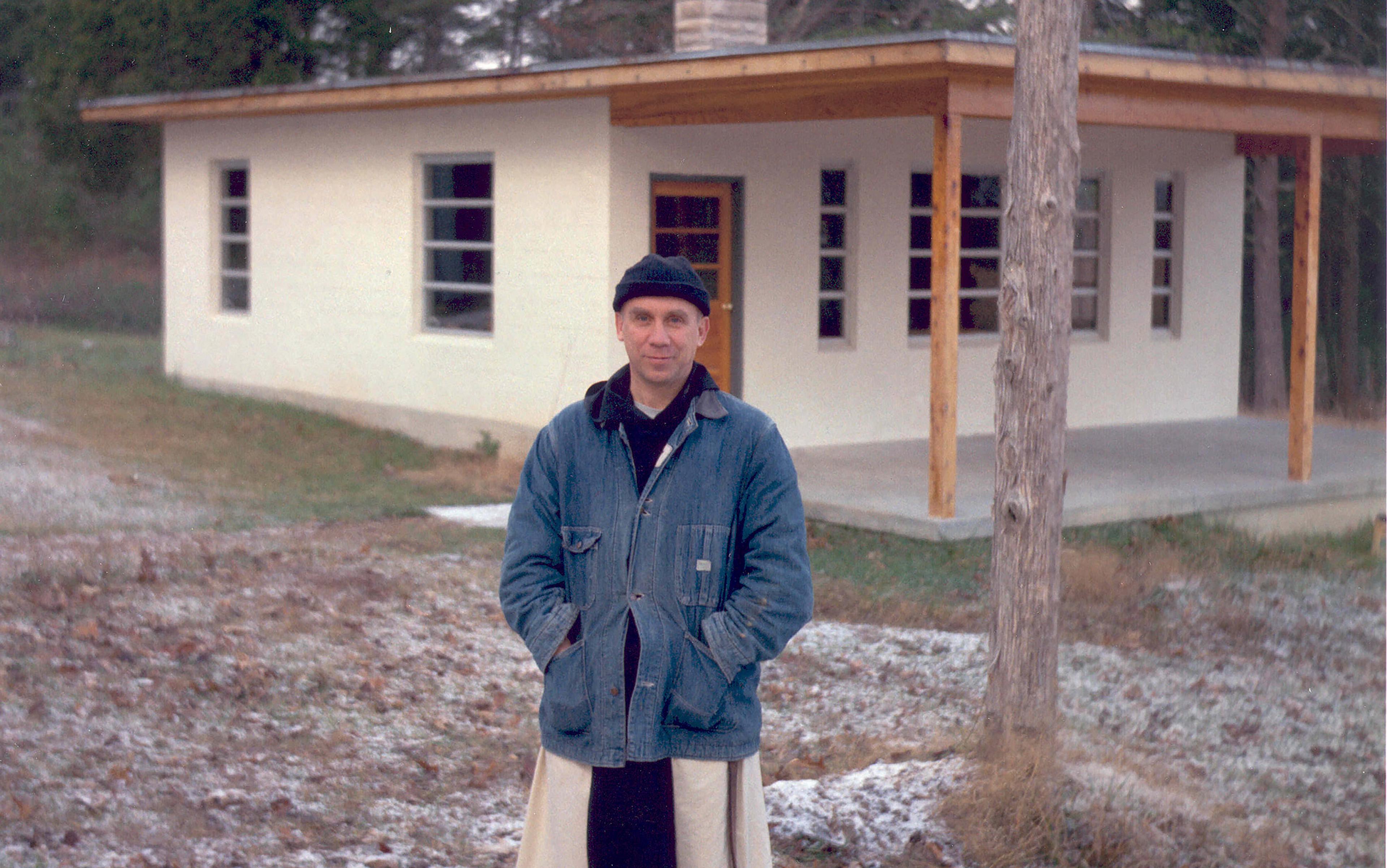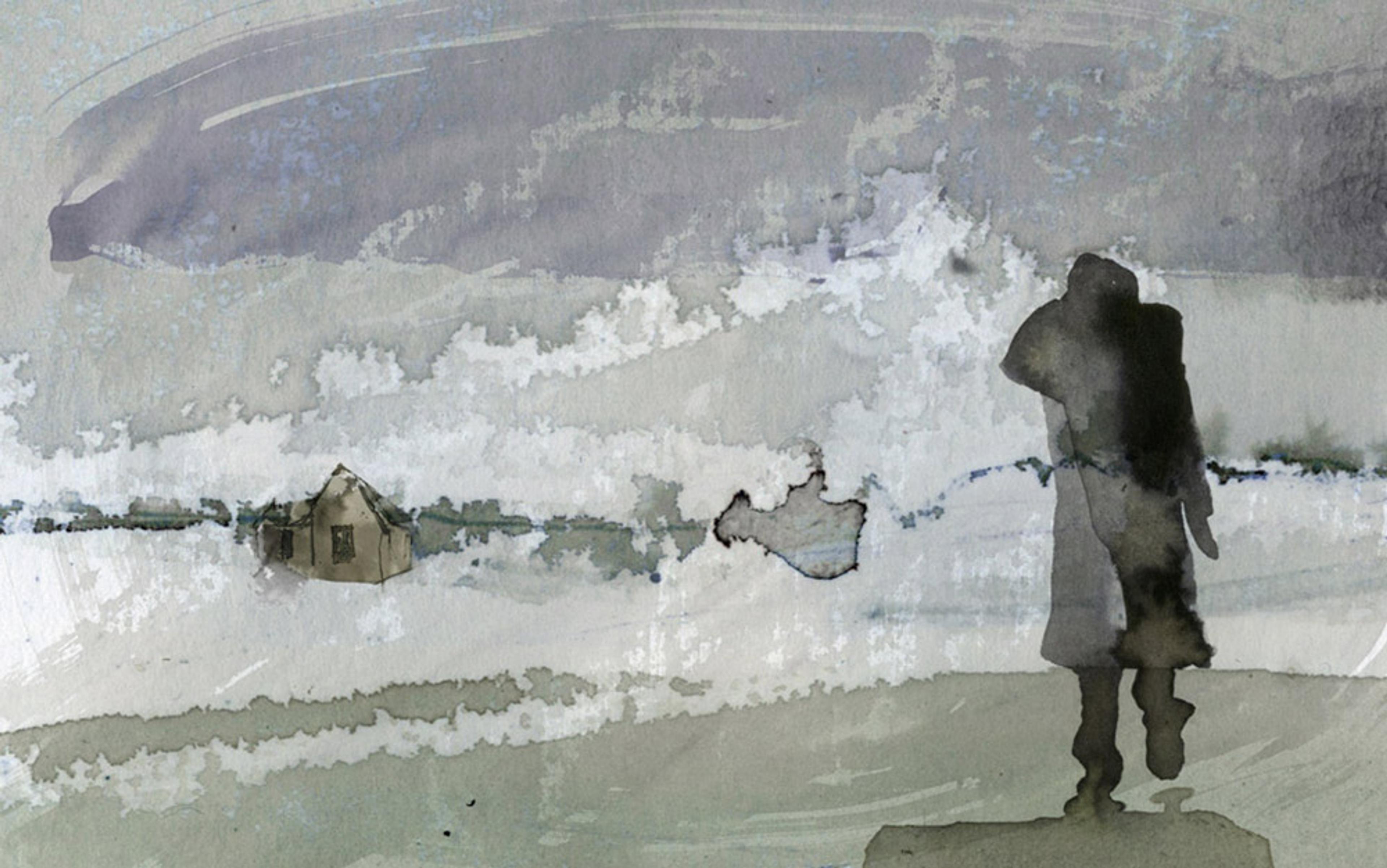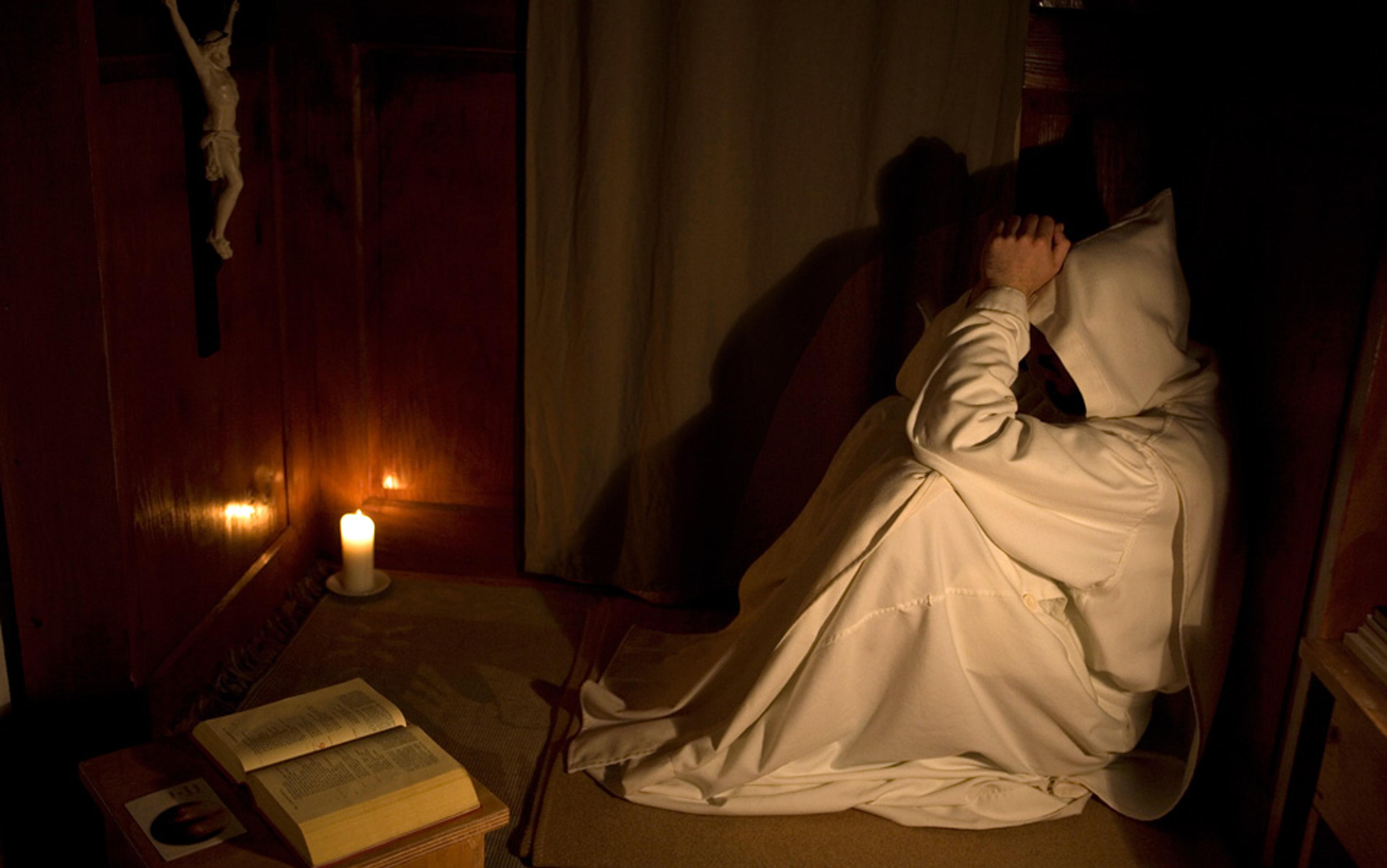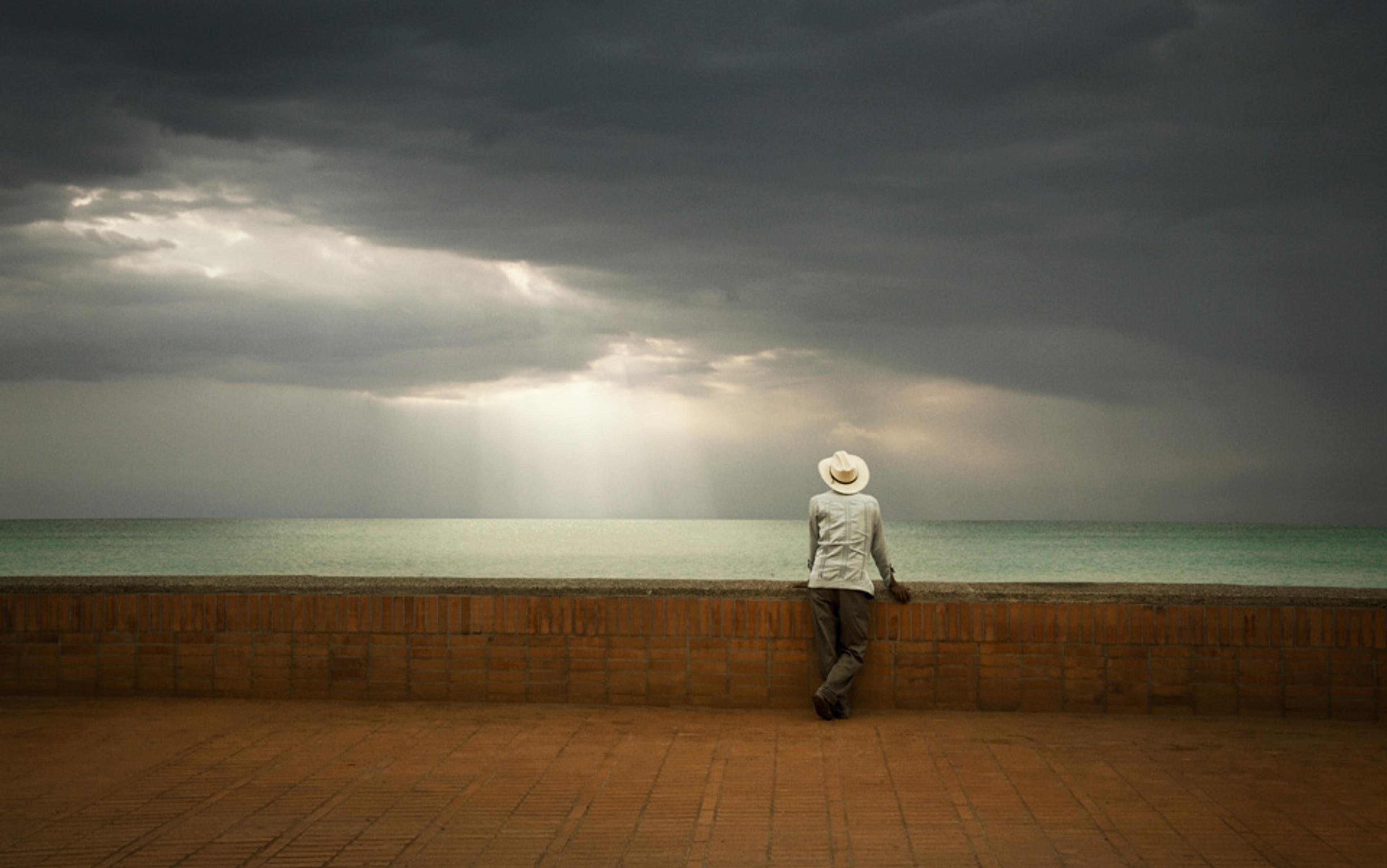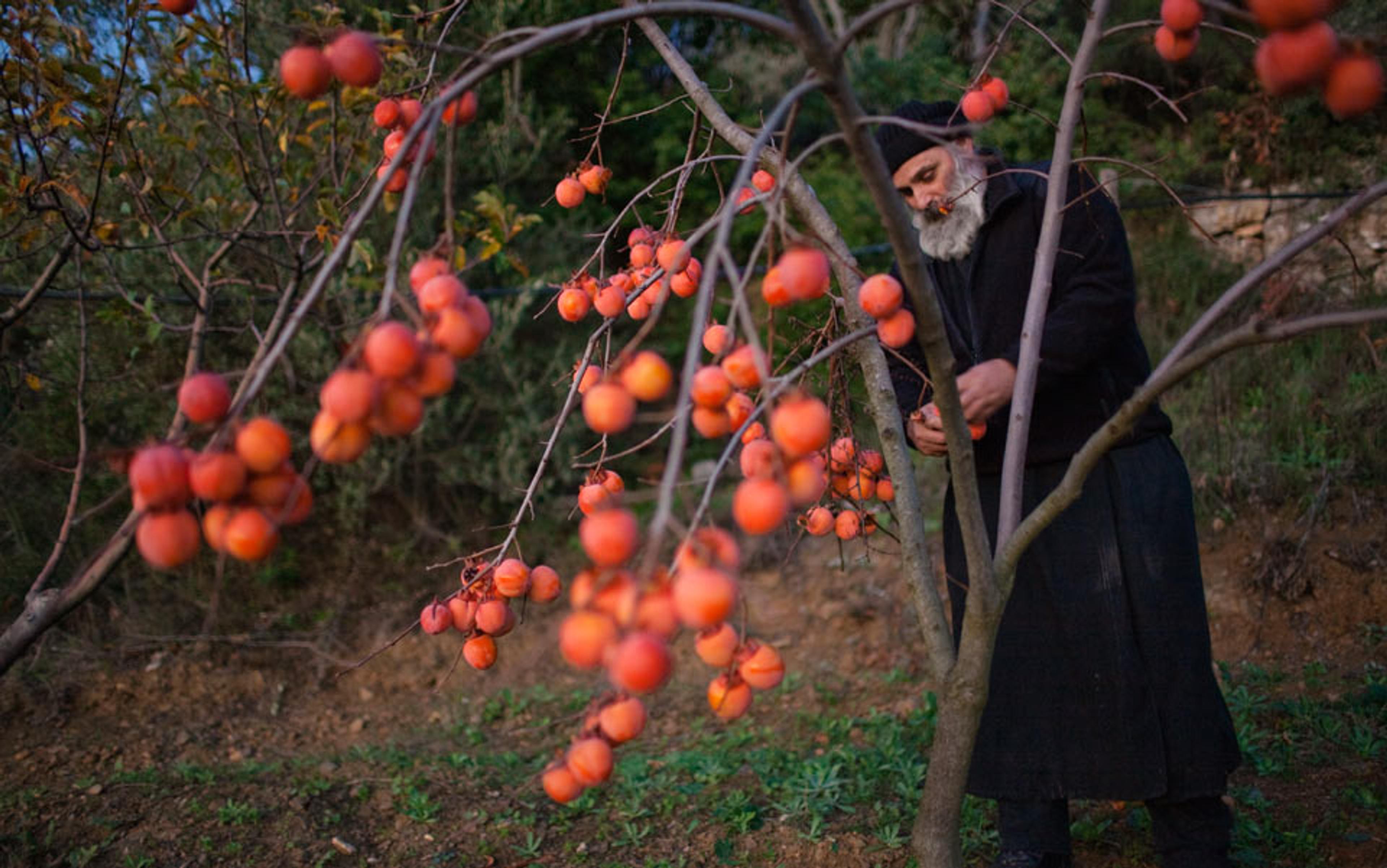The 20th-century Trappist monk and poet Thomas Merton, upon witnessing one of his first services at the Abbey of Gethsemani in Kentucky, which would later become his home, wrote: ‘The silence with people moving in it was 10 times more gripping than it had been in my own empty room.’ The silence and solemnity of the masses were so overpowering, he added, they ‘choked me with love and reverence that robbed me of the power to breathe. I could only get the air in gasps.’ His relationship with that silence, which stood at the heart of monastic life, would always be a complex one.
In choosing a life of silence, Merton believed he was leaving a chaotic world on the cusp of the Second World War for one of contemplation, introspection and calm. But his role as a writer – including publication of his critically acclaimed autobiography, The Seven Storey Mountain (1948) – forced him back out: he called his writerly self ‘my double, my shadow, my enemy’. Merton struggled with his desire for the purity of silence and with the need to break it, to the end of days.
One could see his journey through the lens of a childhood marked by restlessness and loss: his mother dead from cancer when he was six; years shuttling between his grandparents on Long Island and his painter father in Bermuda and then France; his father suffering a lingering death when Merton was still a teenager.
His school years in England in the aftermath of that loss were full of nights of carousing that didn’t abate when he returned to the United States to attend Columbia University as an undergraduate. During his time at Columbia, he typically spent evenings with friends in Manhattan, where, he wrote:
we would crawl around the tiny, noisy, and expensive nightclubs that had flowered on the sites of the old speakeasies in the cellars of those dirty brownstone houses. There we would sit, for hours, packed in those dark rooms, shoulder to shoulder with a lot of surly strangers and their girls, while the whole place rocked and surged with storms of jazz.
He’d stay so late that he often missed the last train back to Long Island, where he was living with his grandparents. ‘It was nothing unusual for me to sleep on the floor,’ he recalled, ‘or in a chair, or on a couch too narrow and too short for comfort – that was the way we lived.’
While he was a student in New York, and during the years immediately following, he also read intensely and broadly as he searched for purpose in his life. It was through his reading of Saint Augustine, Thomas à Kempis, John of the Cross and Jacques Maritain in particular, and in his conversations with friends and teachers – specifically Dan Walsh, who taught a course on Thomas Aquinas at Columbia – that Merton found himself drawn to Catholicism. He was eventually baptised into the faith.
Although he looked to his conversion to orient himself in the world, Merton remained unsettled as to what shape his life within the religion would take. His first efforts aimed toward good works. He taught literacy in Harlem, night school at Columbia, and composition at St Bonaventure, a Franciscan college in upstate New York. While at St Bonaventure, he considered joining the Franciscans, which would likely mean a life of teaching. Eventually, he retreated from the idea.
Years later, when he looked back at this time of casting about for his right place, Merton wrote:
What I needed was the solitude to expand in breadth and depth and to be simplified out under the gaze of God more or less the way a plant spreads out its leaves in the sun. That meant that I needed a Rule that was almost entirely aimed at detaching me from the world and uniting me with God, not a Rule made to fit me to fight for God in the world.
Yet monasticism didn’t possess an immediate appeal for him. Up until the year before Merton settled at Gethsemani, he understood little of the life of a cloistered contemplative, and the idea of its silence seemed utterly foreign to him. He was, after all, an unfailingly social soul, loving discussion and engagement in the world of ideas, and he imagined monasticism as an absolute: daily life devoid of speech, devoid of community bonds. He thought it cold and cruel, inhuman, an ‘excessive rejection of the rights of nature’. Walsh disabused him of his notions by explaining that although the monks didn’t casually converse, they did speak at times, and they recited prayers and chanted psalms together. Upon hearing this, Merton recalled: ‘I was relieved to think that the monks got to choir and exercised their vocal cords. I was afraid that so much silence would wither them up altogether.’
During the spring of 1941, Walsh encouraged him to make the retreat at Gethsemani. Merton was 26 years old, exhausted not only by his uncertainty concerning the course of his life, but also by the dark note that had descended upon the world. He himself had described that darkness several years before when he noted the ‘disparate murmurs of different radios in different houses … imperceptibly merg[ing] into one big, ominous unified voice, that moved at you from different directions and followed you down the street … I heard “Germany – Hitler.”’
Merton’s retreat at Gethsemani proved to be even more profound than he could have imagined. While beyond the monastery gates the world descended into war, he was entranced by the Order’s traditions and ceremonies that had been carried forward nearly unchanged since the Middle Ages; by the solemnity, the psalms, the ritual, the sense of the eternal that he found there.
The monastery itself, built of local brick and Indiana limestone in the mid-19th century, had housed a community of monks for nearly 100 years. Merton particularly noticed the anonymity that monastic life offered. During the first days of his retreat, he saw a postulant, a young man in the choir who stood out with his ‘dark secular clothes’. Later he recalled: ‘Then suddenly we saw him no more. He was in white. They had given him an oblate’s habit, and you could not pick him out from the rest.’
Above all, however, it was the silence and solitude that drew Merton in: ‘I had entered into a solitude that was an impregnable fortress. And the silence that enfolded me, spoke to me, and spoke louder and more eloquently than any voice…’ Such a life seemed to offer him everything he was seeking: ‘It was a peace that did not depend on houses, or jobs, or places … It was a peace that time and … the world could not give.’
Before the year was out, he was making preparations to join the Trappists in a permanent way. He had received a medical deferment from the local draft board, though he had been prepared to sign up as a conscientious noncombatant ‘and serve in the medical corps, or as a stretcher bearer, or hospital orderly … so long as I did not have to drop bombs on open cities, or shoot at other men.’
Then he dismantled his life as he knew it. He sent his clothes to Harlem, where he’d once worked, and left most of the books on the shelf in his room at St Bonaventure. He ripped up his novels – three finished, one half-finished – and threw them in an incinerator. He was kinder to his poems, which he sent to one of his teachers at Columbia, Mark Van Doren. He wrote a few notes to friends, then boarded a train to Kentucky. On the eve of the US involvement in the Second World War, he travelled through the bare winter landscape of the Advent season to his new life at Gethsemani.
After being shown to his room, he promptly went to the church to attend his first service. ‘If I expected any grand welcome from Christ and His angels, I did not get it – not in the sensible order. The huge nave was like a tomb and the building was as cold as ice. However I did not mind.’ Given a small measure of time to be unanchored, he moved through his first day, feeling his way, unsure of what would happen next, reading and wondering and attending services.
The following morning the novice master knocked on his door, greeted him, and asked simply: ‘Does the silence scare you?’
Trappists, who follow the Rule of Benedict, are to possess almost nothing of their own, and the material goods of the monastery are common goods. Benedict declares that ‘the abbot is to furnish all necessities: cowl, tunic, shoes, stockings, belt, knife, pen, needle, towel and writing tablet. With these, any excuse for need will be vanquished.’
The success of his autobiography meant that his solitude became very public
When he recalled his first days at the monastery, Merton described a box ‘that was to represent all the privacy I had left: one small box, in which I would keep a couple of notebooks full of poems and reflections and a volume of St John of the Cross … and the letters I would receive.’ His letting go of the world would be every bit as extreme as his letting go of the personal. There would be no newspapers, no radio. The world was to disappear from him just as much as he was to disappear from the world. He would give up his name and be known in the community as Frater Louis.
But he was never destined to be an obscure monk. Although he assumed that he’d leave his writing life behind once he entered the Order, at the urging of his abbot he wrote the story of his young life, his conversion to Catholicism, and his entry into the monastery. The result, The Seven Storey Mountain, became one of the bestselling books in the US. The unforeseen, extraordinary success of his autobiography meant that his solitude became, in its way, very public.
In addition to his obligations to the community, Merton would always be involved in extensive correspondence with readers. Throughout his life at Gethsemani, he received international visitors seeking his opinions and advice, and he fielded frequent requests for books and articles from New York editors and publishers.
He befriended writers, scholars and prominent religious figures from around the world with whom he would correspond, and some of them would come to Gethsemani. The Trappists, too, looked to him to write religious histories and commentary. The pressures and demands of the writing life were enough to send him dreaming of a hermitage.
If Merton’s monastic life seemed far from the world of silence he dreamed of, it also seemed so to some outsiders. Robert Giroux, his editor, recalled: ‘One sign of [The Seven Storey Mountain’s] impact was the resentment it inspired in certain quarters – not only with hostile reviewers, but with fellow religious, who thought it inappropriate for any monk to write. I remember receiving hate mail saying, “Tell this talking Trappist who took a vow of silence to shut up!”’
Monastic life is a radical reorientation that questions the priorities valued by the world beyond its walls, but the world also challenges the monastery and is inextricable from it in many ways. The world has plundered monasteries, monasteries have grown corrupt from within, and their history at times has been steeped in violence. Bernard de Clairvaux, one of the founders of the Cistercian Order, to which Gethsemani belongs, preached the Second Crusade in the 1140s, and proved so persuasive that he convinced untold numbers to join the ranks for the war.
Nonetheless, the silence at the heart of monastic life continues to attract at least some followers, and often more when the world feels particularly corrupt. It has been said that The Seven Storey Mountain drew unforeseen numbers of men to the monastery in the wake of its publication. But perhaps, also, it was the war itself that drew them in. In its aftermath, the country was enjoying a massive economic expansion, but not every returning soldier was going to college or settling down to start a family in the suburbs.
The sounds of modern war were exponentially louder than the conflicts of the Middle Ages: the 20th-century battlefields mired in mud and smoke, the human carnage, the aerial bombings, the open cities on all sides left in ruins. Cathedrals in ruins. Monasteries and remote villages in ruins, too. Hiroshima and Nagasaki. After having endured such a war, young men were willing to sleep on straw, to give up their possessions, to turn their back on the world that had required them to fight. Perhaps such a life could distance these men from what they had endured, or help them to understand it, or bring them to believe in human goodness again.
For Merton, even as the monastery was filling with those seeking a simpler life, his own dream of silence could seem elusive. It was a dream in which one would
entrust oneself completely to the silence of a wide landscape of woods and hills, or sea, or desert; to sit still while the sun comes up over that land and fills its silences with light. To pray and work in the morning and to labour and rest in the afternoon, and to sit still again in meditation in the evening when night falls upon that land and when the silence fills itself with darkness and with stars.
Yet his renown as a writer made it more and more difficult for him to find the smallest measure of silence in his life. So, after more than a decade at the monastery, he petitioned for, and was granted by his superior, time in a small toolshed in the wooded hills of the monastery grounds, which he could use as a hermitage. Merton christened this makeshift, spartan shed St Anne’s. Its surrounding landscape reminded him of walks during his youth throughout Sussex in England, and the silence, simplicity and solitude it offered was exactly what he felt he needed.
Merton found that under the protection of St Anne’s, away from the community and settled in silence, he was more able to bear the incidental and necessary modern noises of the monastery: ‘The tractors in the bottoms would have exasperated me two years ago. I hardly notice them now.’
When is silence power? What did it mean to remain silent when faced with the intolerable?
At the same time, he increasingly came to believe that in any hermitage, no matter how remote, the 20th century could not be ignored. He was aware of Cold War tensions and the buildup of nuclear arms in the postwar era, which was evident even in the choice of monastic readings during meals. On most days, when the monks ate together in silence, one of the members likely read to them many of the same spiritual writings and commentaries that their Order had listened to for centuries. In November 1957, however, as the Trappist community leaned over their meal as prescribed since their founding – milk, vegetables, beans, bread, fish or cheese; nothing with four legs – Merton noted that the reading consisted of something that would have been unfathomable even a few years prior:
Yesterday and today in the refectory first a news article about the two sputniks and the dog in the second one. Then Eisenhower’s speech about science and defence – a fantastic future which, I suppose, we have to take for granted from now on.
Merton knew that a 20th-century monastery was far different from a 12th-century one, and the contemplative life could not be an escape from the political turmoil in his own country. ‘It is futile to try and live in an expanding universe with atomic fission an ever present possibility and try to think and act exclusively as if the cosmos were fixed in an immutable order centred upon man’s earth,’ he wrote in his journals. ‘Modern physics has its repercussions in the monastery and to be a monk one must take them into account, although that does nothing whatever to make one’s spirituality either simple or neat.’ Merton saw the monk’s flight from society as a refusal to participate in its aggression and selfishness, its limited and shortsighted goals. He called it ‘withdrawal from secular time’.
Merton was fully aware of the long, complex history of his monastic Order – its braveries, its purities, its collusions, its corruptions – but in his time alone at St Anne’s, the decision he felt he faced was intensely personal: he was a contemplative monk who was by no means obscure, whose words carried weight. The questions he asked himself were those of a monk and of a citizen: when is silence power? When is one an accomplice to fear? What did it mean to remain silent when faced with the intolerable?
As the Cold War deepened, he could not help but see removal from the world as potentially destructive to the monastic calling:
The contemplative life is not, and cannot be, a mere withdrawal, a pure negation, a turning of one’s back on the world with its sufferings, its crises, its confusions and its errors … The monastic community is deeply implicated, for better or for worse, in the economic, political, and social structures of the contemporary world. To forget or to ignore this does not absolve the monk from responsibility for participation in events in which his very silence and ‘not knowing’ may constitute a form of complicity.
In his essays, journal articles, and letters he began to openly criticise the buildup of nuclear arsenal and Cold War tensions. He wrote in support of Civil Rights.
Merton wanted more for the Church than the Church seemed to want for itself. Vatican II, initiated by Pope John XXIII, had let in some fresh air in 1962: dialogue with other religions, parish priests turning to face their congregations, the celebration of the Mass in the vernacular, relaxed rules concerning silence in the monastery, and restrictions on travel for monks. These changes would make possible Merton’s eventual dialogue with Eastern monasticism, but there remained dark, airless corners of the institution, and he was still obligated to obey his superiors.
Although Merton was free to write as he wished, his final manuscripts were screened by two officially appointed censors of the Cistercian Order. They had to declare that the work contained no doctrinal or moral errors, after which Merton’s abbot had to grant his approval for publication. But approval by the Order wasn’t the end. A Church censor, usually from the archdiocese, had to authorise the work before Merton could publish.
The Seven Storey Mountain was originally rejected by one of the censors of the Order: not on theological grounds but as unripe for publication. Merton was advised to take a correspondence course in English grammar. And in the early 1950s he had trouble with the censors over his second autobiographical work, The Sign of Jonas, an edited journal of his first years of monastic life. By the 1960s, the Church went beyond questioning individual books. It specifically forbade him to write on matters of war and Civil Rights.
‘I am being silenced on the subject of war and peace,’ Merton wrote to James Forest, a peace activist and editor at Dorothy Day’s newspaper, the Catholic Worker. The reasons given were that it was inappropriate for a monk to write on such subjects, that it was a distraction from his calling, and that it falsified the message of monasticism.
Merton found ways of getting around the censors. He wrote articles for the Catholic Worker under the pen names Benedict Monk and Benedict Moore. And his shorter works and those of limited circulation weren’t subject to the formal censors; they required the consent only of his abbot. So he broke down his long works into shorter pieces and disseminated them in the form of mimeographed sheets. He sent out essays and declarations to his wide network of influential people – other writers, university professors, political activists – and his friends mimeographed them and distributed them further. They discussed these works in their classrooms. To Forest at the Catholic Worker Merton suggested: ‘You could write a short article reporting on the appearance of my article and quoting bits from it … I think this is a feasible way of handling material that would otherwise just get jammed up in the censorship machine forever.’
Perhaps existence in uncomplicated times is a dream as elusive as the dream of peace in solitude. All during the buildup of the Cold War, Merton’s solitude was becoming more expansive. He was granted more and more time in the toolshed. Then, in the 1960s, his abbot approved the building of a larger hermitage for him that would also serve as a conference centre – a means of both granting Merton his solitude, and gathering the energy and interest in the Order that his writings had attracted.
In his new hermitage – a modest cement block cabin set back in the woods – he said Vespers, cooked his oatmeal, listened to the rain. He toasted bread in the fireplace; sat on the porch, cordwood stacked behind him. At the desk, which faced a large set of windows, he wrote poems and journal entries, and created ink drawings. If silence grew more precious and joyful to him, it was no less complex. Even in his more solid hermitage, the world intruded.
Deep in a storm-soaked night, he could celebrate the intensity of the rain: ‘There is no clock that can measure the speech of this rain that falls all night on the drowned and lonely forest.’
But the beauty of that rain, even in the countryside and within his monastery’s grounds, could no longer be separated from the larger powers of human aggression. Fort Knox wasn’t far away: ‘Of course at 3:30am, the SAC plane goes over, red light winking low under the clouds, skimming the wooded summits on the south side of the valley, loaded with strong medicine. Very strong. Strong enough to burn up all these woods,’ he wrote.
‘When speech is in danger of perishing … it becomes obligatory for a monk to try to speak’
From all outward appearances, by entering the monastery, Merton had chosen the most clear-cut of lives, with its orderly days of observances, its hierarchies and regulations; but he never saw his place within it in a simple or exclusive way. His allegiance to opposing forces, forged by his own conscience and the consciences of his friends and supporters, was always with him: the contemplative life, which requires silence and solitude; the life of engagement, with its demands of articulation and its outward pull.
The very fact of his long silence, he strongly felt, could add weight to words. ‘Genuine communication is becoming more and more difficult, and when speech is in danger of perishing or being perverted in the amplified noise of beasts,’ he wrote, ‘perhaps it becomes obligatory for a monk to try to speak.’
In 1968, in the spirit of aggiornamento fostered by Vatican II, he was granted the opportunity to travel to Asia to attend several conferences and visit established Cistercian monasteries in the East. In northern India he visited with the Dalai Lama in exile. Merton had long wanted such a meeting, and they spoke over the course of three consecutive days. Then Merton travelled on to Madras and Ceylon (now Sri Lanka) before returning to Bangkok. After several months of lectures, conversations, talks, panels and immersion in foreign landscapes, he was deeply energised by his travels, particularly his encounters with cultures where religion remained at the heart of daily life. The distance from his home had given him a new angle on life and prompted him to contemplate ever more seriously further time away.
On 10 December, at a Red Cross centre near Bangkok, Merton gave a lecture affirming the place of the monastic as an outsider. ‘The monk is essentially someone who takes up a critical attitude toward the world and its structures,’ he remarked, ‘somebody who says, in one way or another, that the claims of the world are fraudulent.’
Afterward, he went back to his cottage to rest and to shower before a scheduled evening panel discussion. He emerged from his shower, walking with wet feet on a wet floor. It’s surmised that he reached for a fan, which was later shown to have faulty wiring, and suffered a fatal electric shock. Merton’s body was flown back to the US on an Air Force transport to Oakland, then sent on a commercial carrier to Louisville. He was laid to rest on 17 December as snow fell in the waning light of day, at the monastery in the Knobs of Kentucky where he had spent half of his 53 years. His burial place is marked, as are all the other graves of the monks of Gethsemani, with a simple white cross.
Excerpted from ‘Silence: A Social History of One of the Least Understood Elements of Our Lives’ by Jane Brox. Copyright © 2019 by Jane Brox. Used by permission of Houghton Mifflin Harcourt Publishing Company. All rights reserved.
